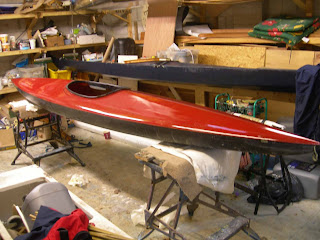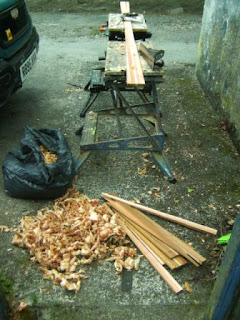2017
2017 a year of changed direction
I recently added this to my website:
" Although I am happy to answer any queries or supply cloth I will not be taking any skin on frame or paddle orders in 2017: this year is devoted to developing new products"
Developing new products
The Lowen
I am indebted to Tom for commissioning me to build a kayak of Brian Schultz's F1 design. When this proved impossible, I drafted the Lowen, a kayak based on the Mariner Coaster (on which the F1 was based), but adapted for the conditions in UK waters; it performed very well and looked good too. In particular I was pleased with the neutral handling in wind i.e. no weather-cocking and without the fitment of a skeg.
In response to a request for a set of plans I am currently learning how to use Turbo Cad in order to do this and am also planning to build an epoxy ply version. I have drafted the plans for this in Freeship and it is simply a matter of finding the time to put it together.
Sea going Slalom Canoe

This project is something I have wanted to complete for about five years. I made a start last year by purchasing an Mendesta Slalom kayak that was probably made between 1964 and 1970 when it would have become obsolete. Although the kayak weather-cocked quite badly until I added an external keel it was surprisingly fast, a pleasure to paddle, rolled beautifully and was a gem around the rocks or in surf. Much work to be done though.
Short Racing Kayak
With a few adjustments this is actually a stretched and squeezed version of the 12' kayak I made for Dave a couple of years ago. Again this is something I have wanted to build for a while and is about the concept of a boat being designed for a certain speed.
If for example I were to design a racing kayak that would be most efficient at over 8 knots, it would be most likely to be less efficient at other speeds. Older paddlers like me do not have the stamina to paddle at those sorts of speeds; most of the races in which I finish are completed at something like six knots.
The design shown above is a little over a foot shorter than the full length K1 at just under sixteen feet in length, and slightly beamier. This gives a boat with significantly less wetter area to give much less resistance at lower speeds, and with a high Prismatic coefficient the resistance at six knots would still be less than a comparable full length K1.
The flaw in this plan is that races are generally won on the sprints at the start and finish, however the purpose of this kayak would not be to win races, but finish in a respectable position, thereby scoring valuable Hasler Trophy points for the club - which is what club racing is mostly about these days.
Finally the predicted resistance of the kayak on the Kaper programme is just three pounds at four knots and just over five and a half pounds at five knots; this is something you could paddle all day in the Devizes to Westminster race and still have something left for the next day's leg.
A project that might somehow get slotted in.
I recently added this to my website:
" Although I am happy to answer any queries or supply cloth I will not be taking any skin on frame or paddle orders in 2017: this year is devoted to developing new products"
Developing new products
The Lowen
I am indebted to Tom for commissioning me to build a kayak of Brian Schultz's F1 design. When this proved impossible, I drafted the Lowen, a kayak based on the Mariner Coaster (on which the F1 was based), but adapted for the conditions in UK waters; it performed very well and looked good too. In particular I was pleased with the neutral handling in wind i.e. no weather-cocking and without the fitment of a skeg.
In response to a request for a set of plans I am currently learning how to use Turbo Cad in order to do this and am also planning to build an epoxy ply version. I have drafted the plans for this in Freeship and it is simply a matter of finding the time to put it together.
Sea going Slalom Canoe

This project is something I have wanted to complete for about five years. I made a start last year by purchasing an Mendesta Slalom kayak that was probably made between 1964 and 1970 when it would have become obsolete. Although the kayak weather-cocked quite badly until I added an external keel it was surprisingly fast, a pleasure to paddle, rolled beautifully and was a gem around the rocks or in surf. Much work to be done though.
Short Racing Kayak
With a few adjustments this is actually a stretched and squeezed version of the 12' kayak I made for Dave a couple of years ago. Again this is something I have wanted to build for a while and is about the concept of a boat being designed for a certain speed.
If for example I were to design a racing kayak that would be most efficient at over 8 knots, it would be most likely to be less efficient at other speeds. Older paddlers like me do not have the stamina to paddle at those sorts of speeds; most of the races in which I finish are completed at something like six knots.
The design shown above is a little over a foot shorter than the full length K1 at just under sixteen feet in length, and slightly beamier. This gives a boat with significantly less wetter area to give much less resistance at lower speeds, and with a high Prismatic coefficient the resistance at six knots would still be less than a comparable full length K1.
The flaw in this plan is that races are generally won on the sprints at the start and finish, however the purpose of this kayak would not be to win races, but finish in a respectable position, thereby scoring valuable Hasler Trophy points for the club - which is what club racing is mostly about these days.
Finally the predicted resistance of the kayak on the Kaper programme is just three pounds at four knots and just over five and a half pounds at five knots; this is something you could paddle all day in the Devizes to Westminster race and still have something left for the next day's leg.
A project that might somehow get slotted in.



Comments
Post a Comment